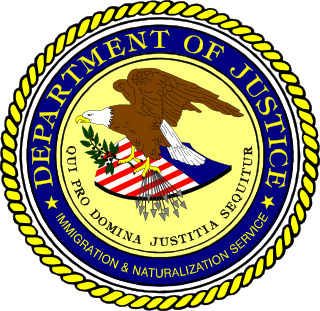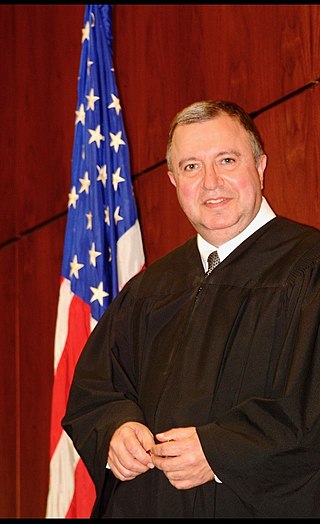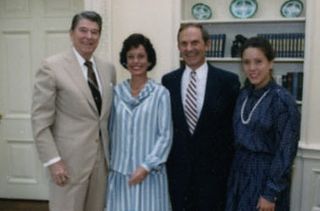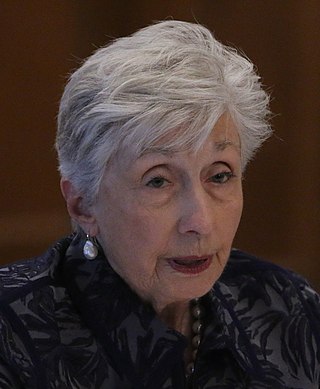
The United States Immigration and Naturalization Service (INS) was an agency of the U.S. Department of Labor from 1933 to 1940 and the U.S. Department of Justice from 1940 to 2003.

The United States Customs Service was a federal law enforcement agency of the U.S. federal government. Established on July 31,1789,it collected import tariffs,performed other selected border security duties,as well as conducted criminal investigations.

The Immigration Reform and Control Act was passed by the 99th United States Congress and signed into law by U.S. President Ronald Reagan on November 6,1986.
Immigration and Naturalization Service v. Chadha,462 U.S. 919 (1983),was a United States Supreme Court case ruling in 1983 that the one-house legislative veto violated the constitutional separation of powers.
In law,an alien is generally any person who is not a citizen or a national of a specific country,although definitions and terminology differ across legal systems.
The Nicaraguan Adjustment and Central American Relief Act or NACARA is a U.S. law passed in 1997 that provides various forms of immigration benefits and relief from deportation to certain Nicaraguans,Cubans,Salvadorans,Guatemalans,nationals of former Soviet bloc countries and their dependents who had applied for asylum. As these Central Americans overwhelmed the U.S. asylum program in the mid-1990s,their cases were left for NACARA to address.

Mark Whitty Everson is an American politician who is currently the Vice Chairman of alliantgroup and served as the 46th Commissioner of Internal Revenue from 2003 until 2007. Prior to his appointment as Commissioner of the IRS,Everson held a number of federal government positions in the administrations of George W. Bush and Ronald Reagan,as well as at the state level within the administration of Indiana Governor Mitch Daniels.

The Board of Immigration Appeals (BIA) is an administrative appellate body within the Executive Office for Immigration Review of the United States Department of Justice responsible for reviewing decisions of the U.S. immigration courts and certain actions of U.S. Citizenship Immigration Services,U.S Customs and Border Protection,and U.S. Immigration and Customs Enforcement. The BIA was established in 1940 after the Immigration and Naturalization Service was transferred from the United States Department of Labor to the Department of Justice.
The Sanctuary movement was a religious and political campaign in the United States that began in the early 1980s to provide safe haven for Central American refugees fleeing civil conflict. The movement was a response to federal immigration policies that made obtaining asylum difficult for Central Americans.

The Organized Crime Drug Enforcement Task Force (OCDETF) is a federal drug enforcement program in the United States,overseen by the Attorney General and the Department of Justice. The principal mission of the OCDETF program is to identify,disrupt,and dismantle the major drug trafficking operations and tackle related crimes,such as money laundering,tax and weapon violations,and violent crime,and prosecute those primarily responsible for the nation's drug supply.

Samuel Der-Yeghiayan is a former United States District Court Judge of the Northern District of Illinois. He was appointed in 2003. Der-Yeghiayan is noteworthy as being the first Armenian immigrant U.S. District Court Judge in the United States and served over 40 years of distinguished government service.
Immigration and Naturalization Service v. Doherty,502 U.S. 314 (1992),was a United States Supreme Court case which confirmed that the Attorney General of the United States has broad discretion to reopen deportation proceedings,as well as other adjudications heard before immigration courts.
During the 18th and most of the 19th centuries,the United States had limited regulation of immigration and naturalization at a national level. Under a mostly prevailing "open border" policy,immigration was generally welcomed,although citizenship was limited to “white persons”as of 1790,and naturalization subject to five year residency requirement as of 1802. Passports and visas were not required for entry into America,rules and procedures for arriving immigrants were determined by local ports of entry or state laws. Processes for naturalization were determined by local county courts.

Thomas Crooks Ferguson was an American diplomat and lawyer who served as Ambassador to Brunei and a U.S. government official. He served as deputy commissioner and chief operating officer of the Immigration and Naturalization Service.

Doris Marie Meissner is a former Commissioner of the Immigration and Naturalization Service (INS),the agency previously responsible for immigration enforcement in the United States. She headed the INS from October 18,1993 to November 18,2000,under United States President Bill Clinton and United States Attorney General Janet Reno. She is currently Senior Fellow and Director of the U.S. Immigration Policy Program at the Migration Policy Institute and has previously worked at the Carnegie Endowment for International Peace.
Family Fairness was a program run by the Immigration and Naturalization Service in the United States from late 1987 to late 1990 that granted deferred action to spouses and children of immigrants who were granted amnesty in 1986. The initial version was introduced in late 1987 by then INS Commissioner Alan C. Nelson,working under then Attorney General Edwin Meese and then President Ronald Reagan. An expansion of the program was introduced in early 1990 by INS Commissioner Gene McNary working under then Attorney General Dick Thornburgh and then United States President George H. W. Bush. The program was created through executive action,in order to meet the problem of "split-eligibility" families created by the Immigration Reform and Control Act of 1986,pending legislation that would address the issue. The Immigration Act of 1990 replaced it with a legislatively sanctioned Family Unity Program,that continues to be in force today.
Federation policy oversees and regulates immigration to the United States and citizenship of the United States. The United States Congress has authority over immigration policy in the United States,and it delegates enforcement to the Department of Homeland Security. Historically,the United States went through a period of loose immigration policy in the early-19th century followed by a period of strict immigration policy in the late-19th and early-20th centuries. Policy areas related to the immigration process include visa policy,asylum policy,and naturalization policy. Policy areas related to illegal immigration include deferral policy and removal policy.
The Immigration Examinations Fee Account (IEFA) is an account in the Treasury of the United States into which all revenues collected from fees for immigration and naturalization are deposited,and that is used to fund the costs associated with providing the immigration and naturalization benefits. The account funds most of the operations of the United States Citizenship and Immigration Services (USCIS),the sub-agency of the U.S. Department of Homeland Security that is tasked with most of the associated work.
The Orantes-Hernandez injunction is a federal court decision stemming from an initial 1982 class-action lawsuit,Orantes-Hernandez v. Smith,filed by a group of Salvadoran immigrants that had been mistreated while in custody of the Immigration and Naturalization Service in the United States. This class-action lawsuit was filed against U.S. immigration authorities for violating rights of Salvadorans,specifically in detention centers. The injunction,a legal order to stop certain behaviors,listed several practices that had been taking place in the treatment of detainees,citing them as "prohibited acts". These included misinforming or failing to inform immigrants of their right to apply for political asylum,using coercive tactics to encourage Salvadorans to elect voluntary departure,and denying detainees access to counsel. Colloquially known as the Orantes-Hernandez injunction,these legal proceedings have been both appealed and upheld in court various times since the initial decision in 1982.









